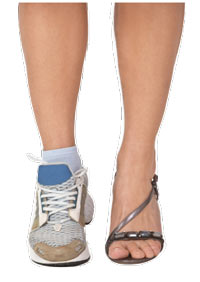Shin splints is one of the more common problems that can occur in active patients, especially during the spring and summer months. It is important to maintain an awareness of this frequent complaint and know the signs to look for during diagnosis. Help keep your active patients in step with their lifestyles!
Symptoms
The pain associated with shin splints can be in multiple locations or an individual area. The most common areas are along the inside or medial side of the tibia (shin bone) to just above your ankle bone (medial malleolus) and on the outside or lateral side of the tibia (shin bone). A third location can be behind the outside or lateral ankle bone (lateral maleolus); this pain can begin behind the ankle and radiate underneath the ankle bone and continue down into the foot.
Causative Factors
One of the causes for the pain associated with shin splints is excessive pronation, or rolling in of the foot. This causes a reduction in the arch of the foot so that the foot flattens. In turn, the flattening of the arch creates excessive pulling and stress on the muscles and ligaments of the lower leg, which all insert into the top or bottom of the foot.

Other causes can be from improper shoes, both from lack of adequate arch support, and wrong shoe styles based on your foot structure. Additionally, muscle imbalances may have occurred from poor biomechanics during running or the gait cycle. Other gait-related issues can be from foot placement during the gait cycle and cause additional stresses to be placed on the lower leg musculature.
Sudden changes in training, like increasing mileage too soon or excessive running on an incline or decline, place more stresses on the lower leg musculature.
Treatment
One of the first courses of action is assessing the gait cycle to correct poor technique and to help recognize postural deficits that may have resulted. This allows more precise determination in rehabilitation procedures and other care options.
Take care to recommend the proper shoe to match your patient’s foot type or structure. Additionally, consider the possibility of custom-made Spinal Pelvic Stabilizers, also known as orthotics, for additional correction or support of excessive movement within the foot.
Rehabilitation will include appropriate stretches based on the muscle groups that are involved. When needed, strengthening will be recommended through functional drills or specific exercises using rehab bands or other rehabilitation devices.
If postural or structural imbalances are noted, a recommendation for a chiropractic spinal examination may be recommended to correct these imbalances. This will be done through safe chiropractic manipulative therapies using either manual means or specific instrumentation based on what will serve your patient’s present condition.
A 1980 graduate of Palmer College of Chiropractic, Dr. Kirk Lee is a member of the Palmer College of Chiropractic Post Graduate Faculty and Parker College of Chiropractic Post Graduate Faculty. He has lectured nationwide on sports injuries and the adolescent athlete, and currently practices in Albion, Michigan. Dr. Lee can be reached at [email protected].
References
1. Gatorade Sports Science Institute, Sports Science Exchange. Should you Stretch before exercise? Vol. 20, Number 1. 2007.
2. McGill, S, PhD. Ultimate Back Fitness and Performance. Wabuno Publishers. 2004.
3. Alter, M. Understanding Flexibility. Sport Stretch. Human Kinetics. 2000.
4. Anderson, B. Stretching. Shelter Publications. 2000.
